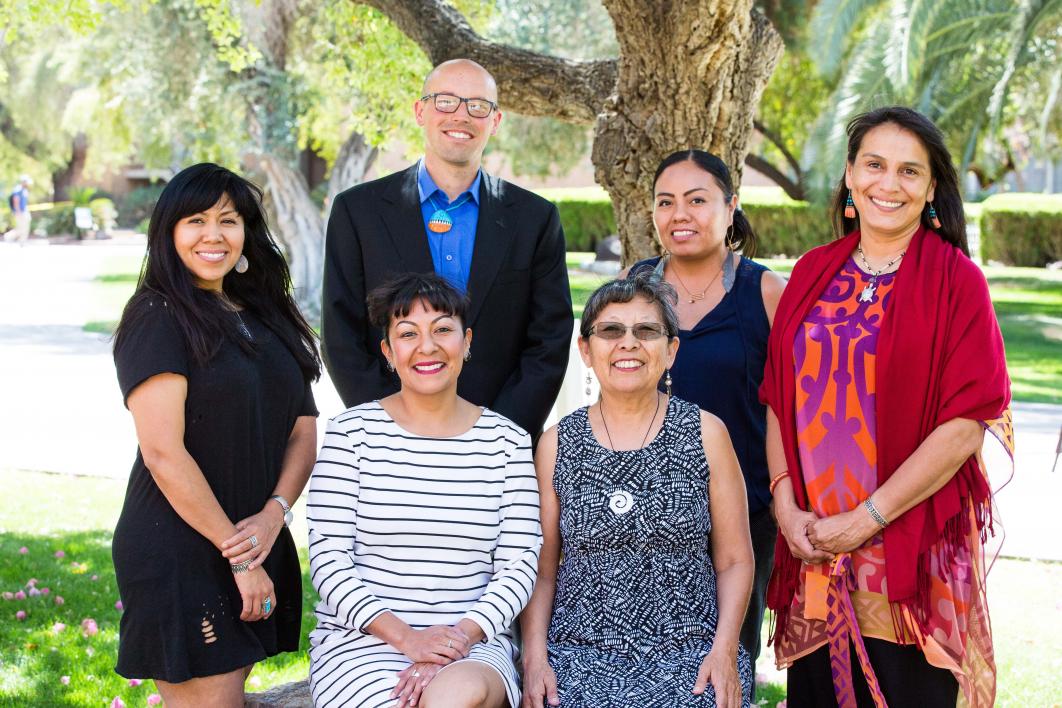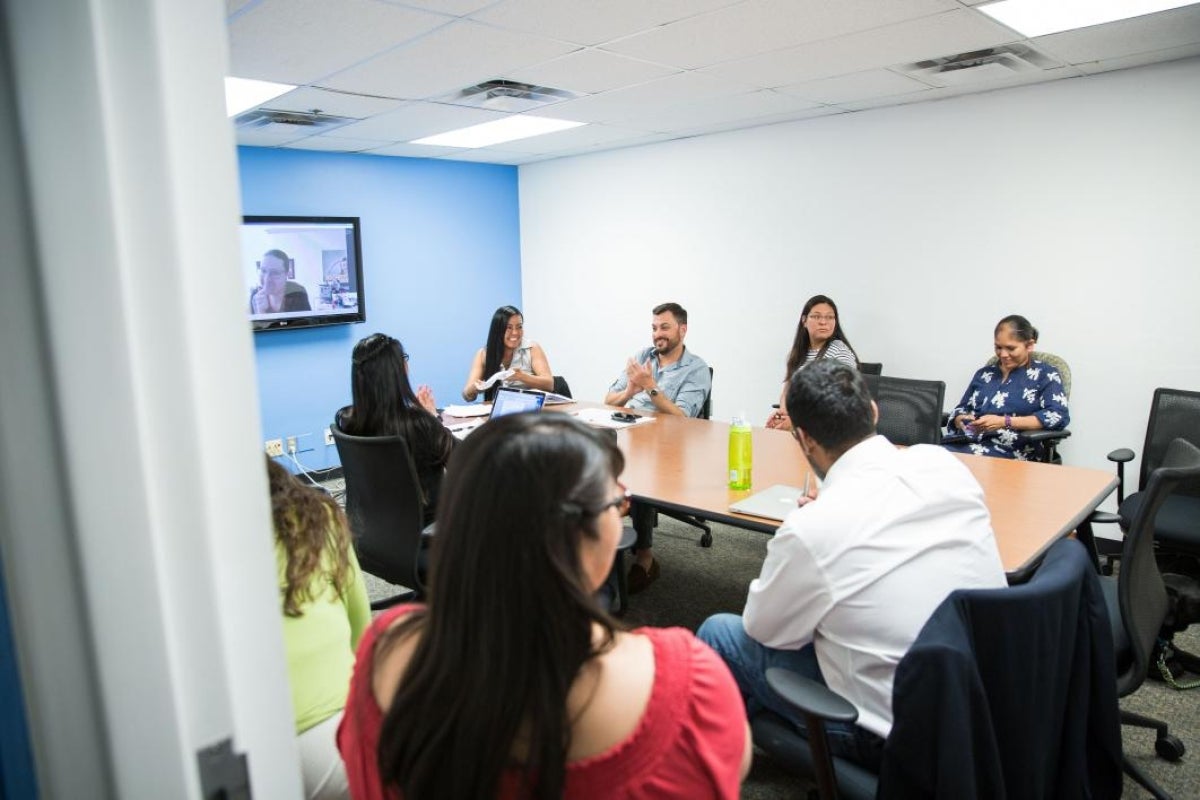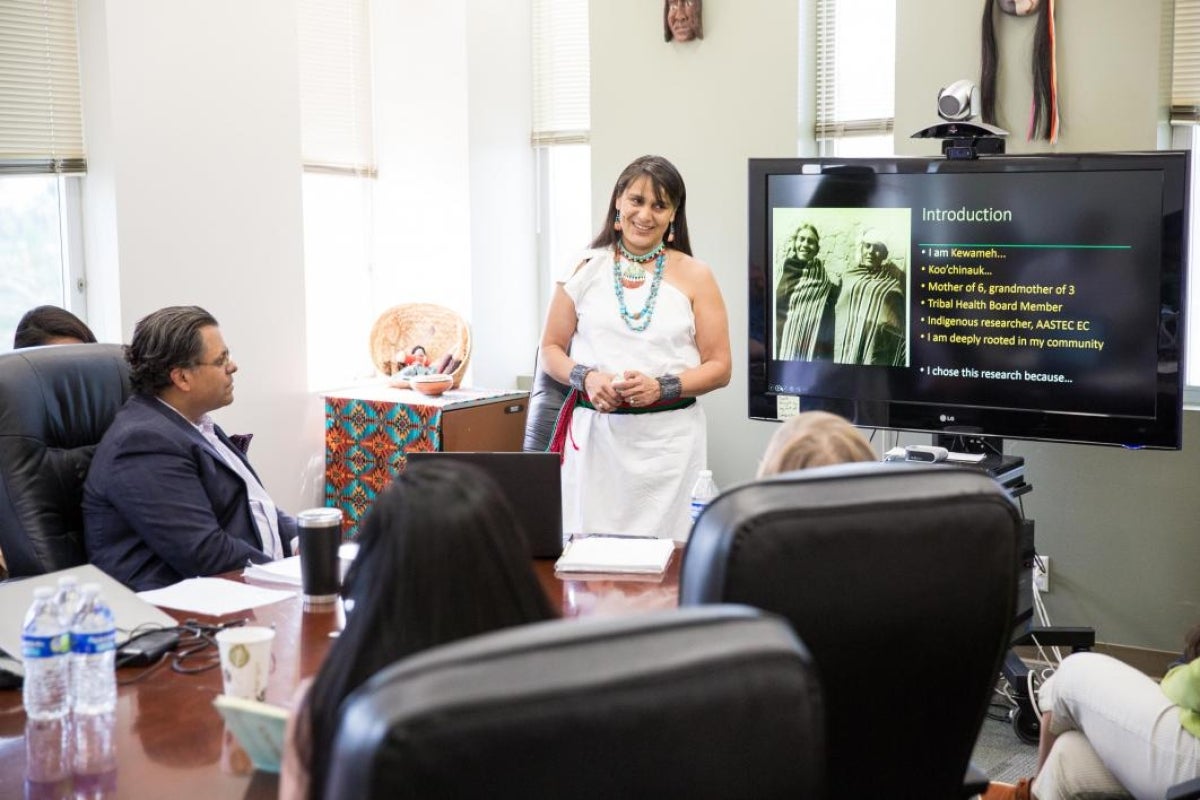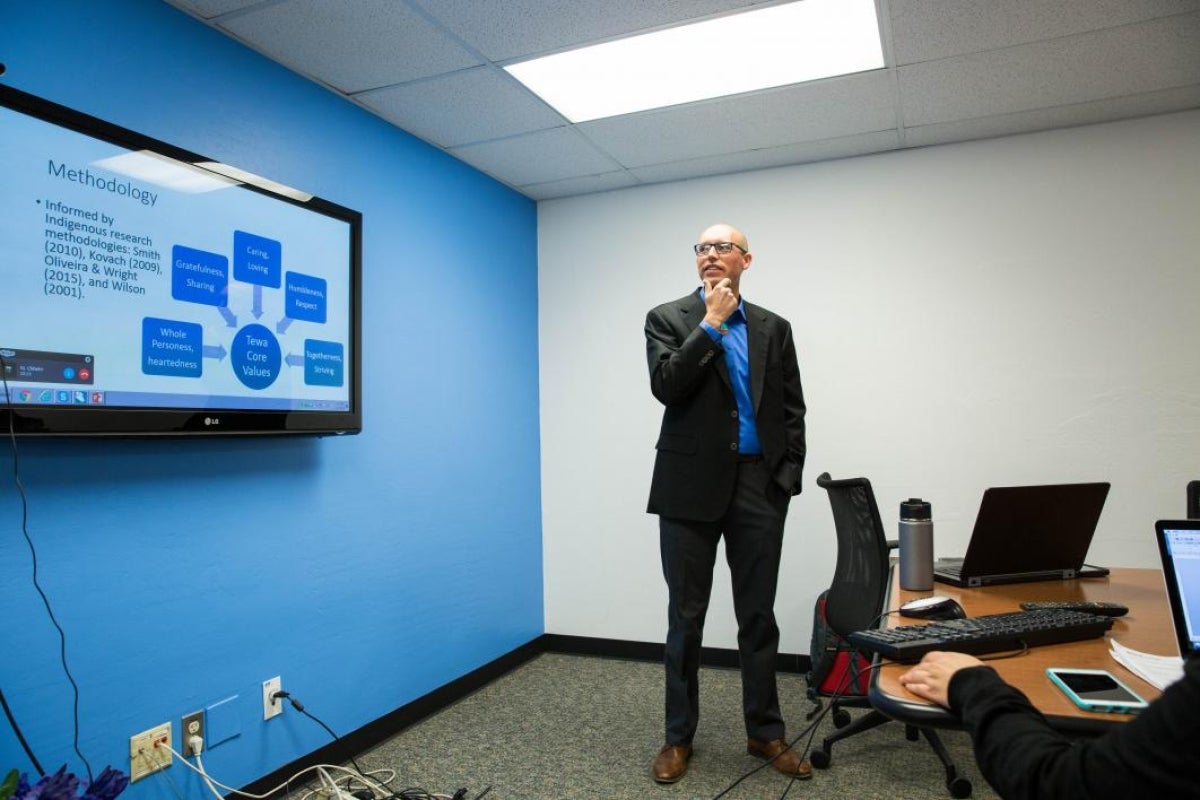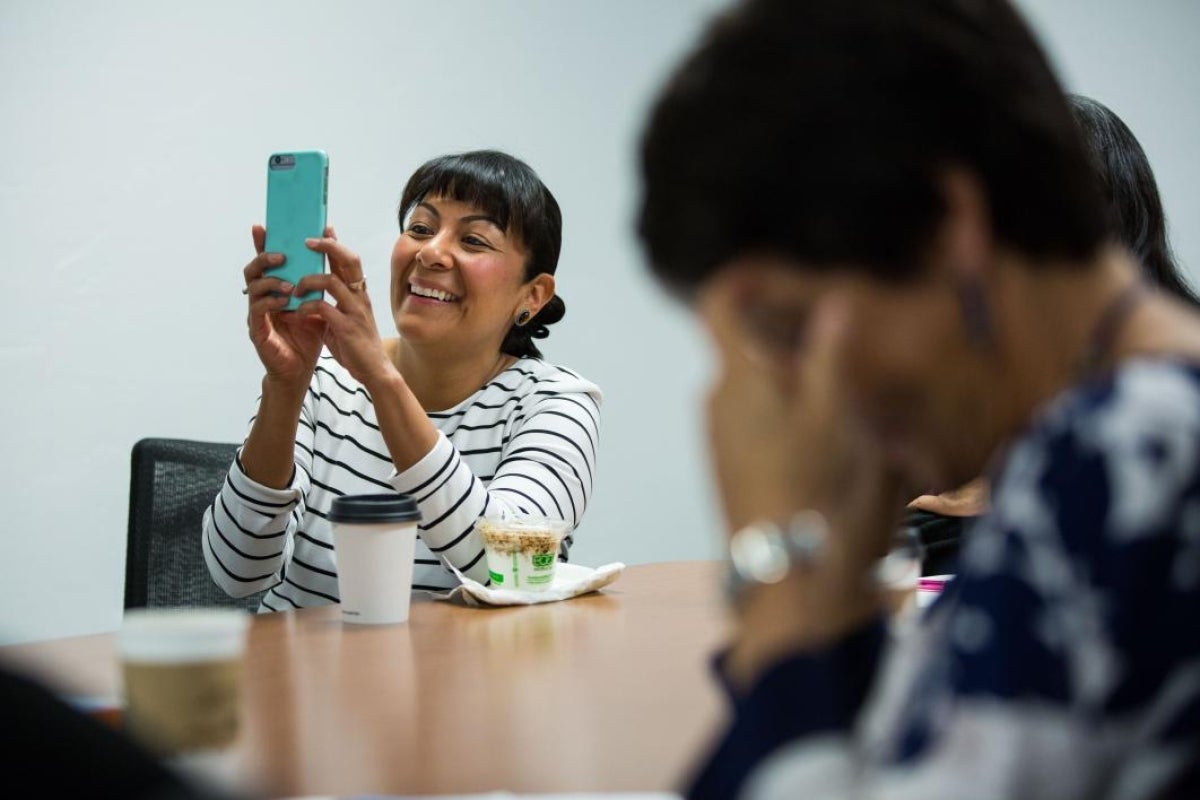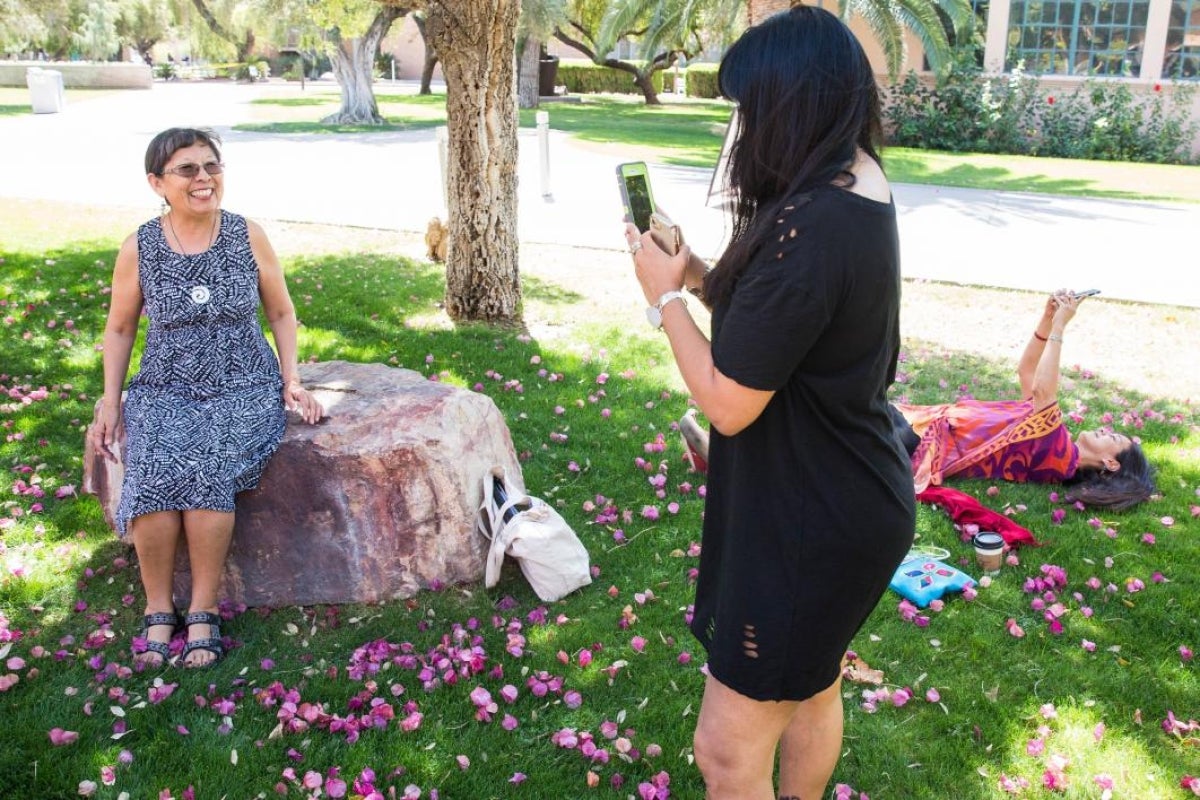Most people go to college to enhance their education, bolster their professional status and increase their earning power. But a doctoral cohort from New Mexico got their degrees to enrich their communities and build up their nation.
Meet the Arizona State University Pueblo Indian doctoral program Class of 2018.
“When our tribal leaders came to our orientation to give their blessing and a word of encouragement, they told us that we were about to embark on a spiritual journey,” said Doreen Bird, who received a doctorate from ASU’s School of Transformation this week after three years of hard work, research and sacrifice. “We realized at that point it wasn’t about us anymore. It’s about our communities.”
Bird is one of six people in the cohort, which saw its second class graduate on May 7.
Weeks before, Bird wore traditional Pueblo attire to her dissertation where she faced a roomful of Native American scholars.
“They were tough and challenged us every step of the way,” said Bird, who quit her job to finish her dissertation on Pueblo research methodologies. “I’m relieved it’s over but excited for the new journey that awaits all of us.”
Pueblo cohort members Christina Castro, Porter Swentzell, Amanda Montoya (front), Peggy Bird (front), Rachell Tenorio and Doreen Bird pose for a portrait following the defense of their dissertations on ASU's Tempe campus on Thursday, April 12, 2018. Photo by Deanna Dent/ASU Now
The program was launched in 2012 as a partnership with New Mexico Pueblos to find solutions to complex issues facing their communities. The hope was for the graduates to be able to establish research agendas, engage in policymaking and enact strategies to address these challenges.
Built with the Leadership Institute at the Santa Fe Indian School, which is under the leadership of the 19 Pueblos of New Mexico, the program facilitates the training of practitioner-researcher-scholars within Pueblo communities.
The members of the cohort conducted their studies in New Mexico, creating a unique set of logistical opportunities. Coursework was conducted primarily through in-person courses with ASU-based faculty and focusing on issues of Pueblo peoples. These included Native health, education, families and communities. Their coursework also included international indigenous-community visits and concentrated training in indigenous research methodology and methods.
The program is led by School of Social Transformation faculty members Elizabeth Sumida Huaman, associate professor of indigenous education and a senior researcher with the Leadership Institute, and Bryan McKinley Jones Brayboy, President’s Professor, director of the Center of Indian Education and ASU’s special adviser to the president on American Indian Affairs.
“This program is a testament to what awesome results can be achieved from real collaboration with indigenous communities, which involves trust, creativity, and hard work,” Huaman said. “All of us who put this program together — the generations who produced the students, and the students themselves — exemplify this … this graduating cohort is the realization of our collective best hopes. They are intensely strong, intellectually and as researchers, and they are among the best people I know.”
Brayboy said Pueblos receiving their degrees is a monumental achievement; only one out of every 5,000 Native Americans and indigenous peoples in the U.S. who reach the ninth grade will go on to obtain a doctorate. He believes the achievement will help cohort members strengthen their pueblosThe term pueblo can also be used to describe the community, in addition to the people..
“I love this program, because it allows us to enact ASU’s vision that we work with tribal nations to create futures of their own making,” Brayboy said. “This process is exactly what self-determination looks like: tribal peoples doing work for their tribal communities. It’s an honor to be a part of the work.”
Amanda Montoya is a Taos Pueblo community planner and defended her thesis in April. Her work is focused on why educated people end up leaving their pueblos, otherwise known as “brain drain.”
“They might leave for a time but they always come back for cultural connections,” Montoya said. “I’ve discovered it’s not just a problem with pueblos but rural communities.”
Montoya said she experienced a brain drain of another kind in obtaining her degree.
“It was a huge sacrifice,” Montoya said. “The day I finished my dissertation, I took a deep breath and said, ‘I can be part of the world again!’”
The program was also a struggle for Christina Castro, whose grandfather Benjamin died on Feb. 6.
“I wasn’t sure I was going to make it. I was going to give up but then I thought, ‘My grandfather wouldn’t have wanted that for me,’” she said. “He was so proud that I was going to be the first doctorate in the family. I was coping with that loss, then gained strength from that loss.”
Peggy Bird, who is a pro tem judge in the Nambe and Taos pueblos, presented a powerful dissertation on Pueblo women’s voices, knowledge and resilience in the face of colonization, which she says still exists.
“We’re still dealing with colonization and different policies that are being imposed upon us,” said Bird. “But if you think about our survival, it’s amazing we’re still here … and we’re going to continue to be here.”
Porter Swentzell, a faculty member at the Institute of American Indian Arts, said there were moments of levity in those three intense years of study.
“One of the special things about this cohort is the humor we share,” said Swentzell, whose dissertation was on place-based education and sovereignty. “We have our own inside jokes. We spent a lot of time laughing, joking around, having a good time. All of that laughter is valuable in getting us to this point.”
June L. Lorenzo, a member of the 2015 cohort, attended last month’s dissertation defenses and was relieved to be an observer and not a presenter.
“It’s interesting to see how the energy of the first cohort has continued,” Lorenzo said. “I’m extremely proud of everyone.”
The cohort capped off the program with a visit to Canada in March for an academic exchange with indigenous health scholars at the University of Manitoba in Winnipeg. While there, the cohort competed in an Indigenous 3-Minute Thesis competition held at the University of Winnipeg where cohort members Rachell Tenorio and Doreen Bird took first and third place, respectively.
In addition to Swentzell, Montoya, Castro, Tenorio, and Doreen and Peggy Bird, there are five other Pueblo cohort members on a separate track set for graduation in the 2018–19 academic year.
The Pueblo Indian doctorate cohort receives support from The Leadership Institute at the Santa Fe Indian School, the W.K. Kellogg Foundation, and ASU’s School of Social Transformation in the College of Liberal Arts and Sciences.
More Arts, humanities and education

Grand Canyon National Park superintendent visits ASU, shares about efforts to welcome Indigenous voices back into the park
There are 11 tribes who have historic connections to the land and resources in the Grand Canyon National Park. Sadly, when the park was created, many were forced from those lands, sometimes at…
ASU film professor part of 'Cyberpunk' exhibit at Academy Museum in LA
Arizona State University filmmaker Alex Rivera sees cyberpunk as a perfect vehicle to represent the Latino experience.Cyberpunk is a subgenre of science fiction that explores the intersection of…

Honoring innovative practices, impact in the field of American Indian studies
American Indian Studies at Arizona State University will host a panel event to celebrate the release of “From the Skin,” a collection over three years in the making centering stories, theories and…

